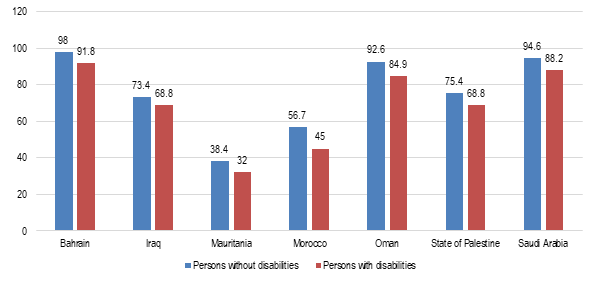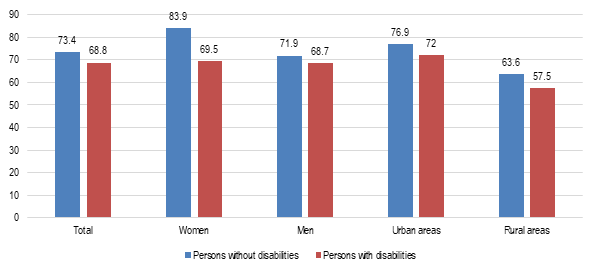Table of contents:
Coverage of Social Insurance
Although there are virtually no statistics available directly pertaining to social insurance coverage among persons with disabilities in the Arab region, data on factors which correlate with social insurance coverage give an indication of the overall picture. As shown in the previous chapter, persons with disabilities, and especially women with disabilities, are on average considerably less likely than persons without disabilities to work. This alone suggests that their social insurance coverage is low, since such coverage is coupled to employment status. Moreover, when they do work, persons with disabilities are disproportionately unlikely to do so on a permanent, salaried basis. This further indicates that persons with disabilities who work are less likely than persons without disabilities to do so formally, since salaried workers are the ones who are most often covered by social insurance.[1]
For example, in Morocco, the overall proportion of workers not covered by social insurance (i.e. the informality rate), has been estimated to 81.9 per cent. However, among salaried employees, the informality rate was 67.1 per cent.[2] Meanwhile, data from the 2014 census indicate that whereas 56.7 per cent of persons without disabilities in employment were salaried employees, the equivalent rate among persons with disabilities in employment was only 45 per cent. As shown by figure 14, the same pattern can be seen in all countries in the region for which data is available.
Details of the situation in Iraq are provided in figure 15. It indicates that persons with disabilities in employment are underrepresented among salaried employees whether they are women or men, and whether they live in urban or rural areas. However, disability appears to have the biggest impact among women, since working women without disabilities are considerably more likely than working women with disabilities to be salaried employees.
In the Arab region, as elsewhere in the world, there is a pronounced correlation between low educational attainment and informal work. For example, it has been estimated that in the Syrian Arab Republic, the informality rate among workers with tertiary education as of 2004 was 24.3 per cent, whereas for workers with only primary education or below, the rate was 86.2 per cent.[3] As shown previously, persons with disabilities’ educational attainments are much lower than those of persons without disabilities, and women with disabilities are especially disfavoured. This further suggests that social insurance coverage among workers with disabilities is likely to be lower than among workers without disabilities, and that it is particularly low among women with disabilities.
Figure 14. Salaried employment as percentage of total employment among persons with and without disabilities aged 15 and above, 2007-2016

Source: Calculated from ESCWA, 2017d, based on data from the: Bahrain, Census 2010; Iraq, I-PMM 2013; Mauritania, Census 2013; Morocco, Census 2014; Oman, Census 2010; State of Palestine, Census 2007; and Saudi Arabia, DHS 2016.
Note: In sources, employment status types other than salaried employee are employer, own-account worker and contributing family worker. For Morocco, Saudi Arabia and State of Palestine there is also unclassified worker.
Figure 15. Salaried employment as percentage of total employment among persons with and without disabilities aged 15 and above, Iraq, 2013

Source: Calculated from ESCWA, 2017d, based on data from the I-PMM 2013.
Almost all Arab countries have employment quotas according to which persons with disabilities must make up a certain percentage of employees in the public and sometimes private sector.[4] Generally, however, the targets set by these quotas are not met,[5] confirming the lack of access among persons with disabilities to formal employment and, thus, to social insurance. Adding to this, the poverty-disability nexus implies that persons with disabilities are also less likely than others to benefit indirectly from social insurance coverage, i.e. from having an insured person in their household.
[1] Angel-Urdinola and Tanabe, 2012, pp. 13-14.
[2] Ibid., pp. 2, 8.
[3] Ibid., p. 12.
[4] ESCWA and the League of Arab States, 2014, pp. 16-17.
[5] See, for example, Egypt, 2015; United Nations Assistance Mission for Iraq and UN OHCHR, 2016, p. 14; Conseil Economique et Social du Maroc, 2012, p. 10; Pinto, Pinto and Cunha, 2016b, p. 39; Stars of Hope Society, 2013, p. 29.